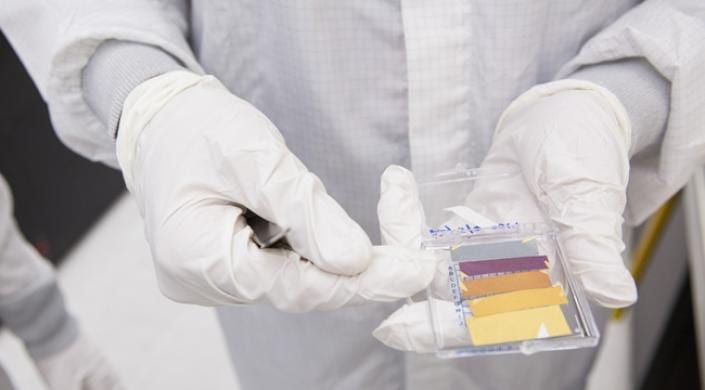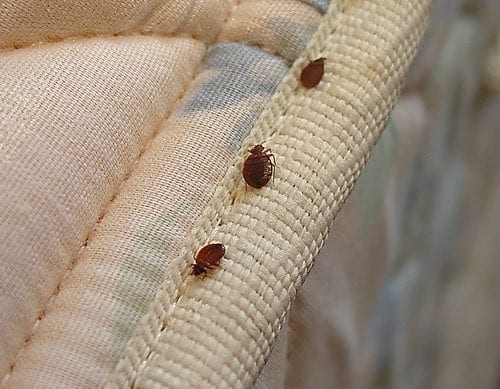
Hands on: Crafting ultrathin color coatings
IN HARVARD’S HIGH-TECH CLEANROOM, APPLIED PHYSICISTS PRODUCE VIVID OPTICAL EFFECTS—ON PAPER
In a sub-basement deep below the Laboratory for Integrated Science and Engineering at Harvard University, Mikhail Kats gets dressed. Mesh shoe covers, a face mask, a hair net, a pale gray jumpsuit, knee-high fabric boots, vinyl gloves, safety goggles, and a hood with clasps at the collar—these are not to protect him, Kats explains, but to protect the delicate equipment and materials inside the cleanroom.
While earning his Ph.D. in applied physics at the Harvard School of Engineering and Applied Sciences, Kats has spent countless hours in this cutting-edge facility. With his adviser, Federico Capasso, the Robert L. Wallace Professor of Applied Physics and Vinton Hayes Senior Research Fellow in Electrical Engineering, Kats has contributed to some stunning advances.
One is a metamaterial that absorbs 99.75 percent of infrared light—very useful for thermal imaging devices. Another is an ultrathin, flat lens that focuses light without imparting the distortions of conventional lenses. And the team has produced vortex beams, light beams that resemble a corkscrew, that could help communications companies transmit more data over limited bandwidth.
Certainly the most colorful advance to emerge from the Capasso lab, however, is a technique that coats a metallic object with an extremely thin layer of semiconductor, just a few nanometers thick. Although the semiconductor is a steely gray color, the object ends up shining in vibrant hues. That’s because the coating exploits interference effects in the thin films; Kats compares it to the iridescent rainbows that are visible when oil floats on water. Carefully tuned in the laboratory, these coatings can produce a bright, solid pink—or, say, a vivid blue—using the same two metals, applied with only a few atoms’ difference in thickness.
Capasso’s research group announced the finding in 2012, but at that time, they had only demonstrated the coating on relatively smooth, flat surfaces like silicon. This fall, the group published a second paper, in the journal Applied Physics Letters, taking the work much further.
“I cut a piece of paper out of my notebook and deposited gold and germanium on it,” Kats says, “and it worked just the same.”
That finding, deceptively simple given the physics involved, now suggests that the ultrathin coatings could be applied to essentially any rough or flexible material, from wearable fabrics to stretchable electronics.
“This can be viewed as a way of coloring almost any object while using just a tiny amount of material,” Capasso says.
Read more: Hands on: Crafting ultrathin color coatings
The Latest on: Ultrathin color coatings
[google_news title=”” keyword=”Ultrathin color coatings” num_posts=”10″ blurb_length=”0″ show_thumb=”left”]
via Google News
The Latest on: Ultrathin color coatings
- Finding Your Perfect Palette: Exploring Coatings Manufacturers and Organic Paint Colorson May 7, 2024 at 5:13 am
Introduction to Coatings Manufacturers and Organic Paint Colors; Choosing the right coating manufacturer and organic paint colours for your painting project can be a daunting task. With so many ...
- Towards transparent and antimicrobial surfaces for touch displayson May 3, 2024 at 9:07 am
Researchers report the development of a durable and transparent antimicrobial surface containing copper nanoparticles. The nanostructured surface was obtained by dewetting ultrathin metal copper films ...
- Nanostructured copper surface shows potential for transparent, antimicrobial surfaces in touch displayson May 3, 2024 at 8:25 am
The interest in antimicrobial solutions for personal and multi-user touch screens, such as tablets and mobile devices, has grown in recent years. Traditional methods like sprayable alcohols or wipes ...
- Best Apple deals for May 2024on April 30, 2024 at 5:00 pm
Image source: Christian de Looper for BGR The new iPad Air sports a 10.9-inch Liquid Retina display with True Tone, P3 wide color ... and we love the ultra-thin design of the M3 MacBook Air.
- Sherwin-Williams Has Announced Its Least Popular Paint Color—See the Underrated Hue Hereon April 25, 2024 at 7:36 am
The announcement is part of the brand's recent campaign coined "The Loneliest Color," which aims to highlight its most overlooked shades. The campaign's inaugural hue is a luminous, rich yellow with ...
- Clip Studio Paint Bundled with Wacom Movink 13, Announced on April 24on April 24, 2024 at 10:18 pm
Celsys, makers of drawing, illustration, comic, manga and animation application CLIP STUDIO PAINT EX, is partnering with Wacom, the leading pen technology company, to bundle an up to 6-month free ...
- The iPhone 16 Pro camera is credited with an ultra-thin coating that will reduce glare and ghostingon April 16, 2024 at 5:39 am
Korean sources claim that Apple is testing a new optical coating technology for future iPhone cameras. It will help improve the quality of photos by reducing artifacts such as flare and ghosting. It ...
- Study reveals why blueberries are blueon February 7, 2024 at 2:19 pm
That was why we knew that there must be something strange about the color," explained Middleton. "So we removed the wax and re-crystallized it on card and in doing so we were able to create a brand ...
- 52 Quick Budget Kitchen Makeover Ideason December 19, 2023 at 10:39 pm
Paint is a simple and cost effective way to completely transform your space. Simply changing the color of your cabinets can make a ... durable rugs that are also ultra-thin, making them perfect to ...
- Lesson 1.2 - Dissolving M&Mson October 9, 2023 at 4:21 am
Observe for about 2 minutes. Show the animation Dissolving an M&M. Explain that water molecules interacted with sugar and coloring molecules in the color coating of the M&M and caused the coating to ...
via Bing News









